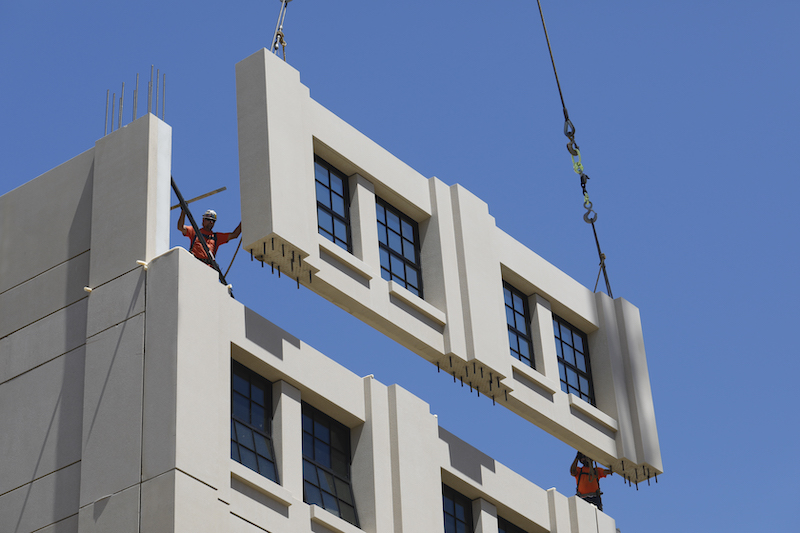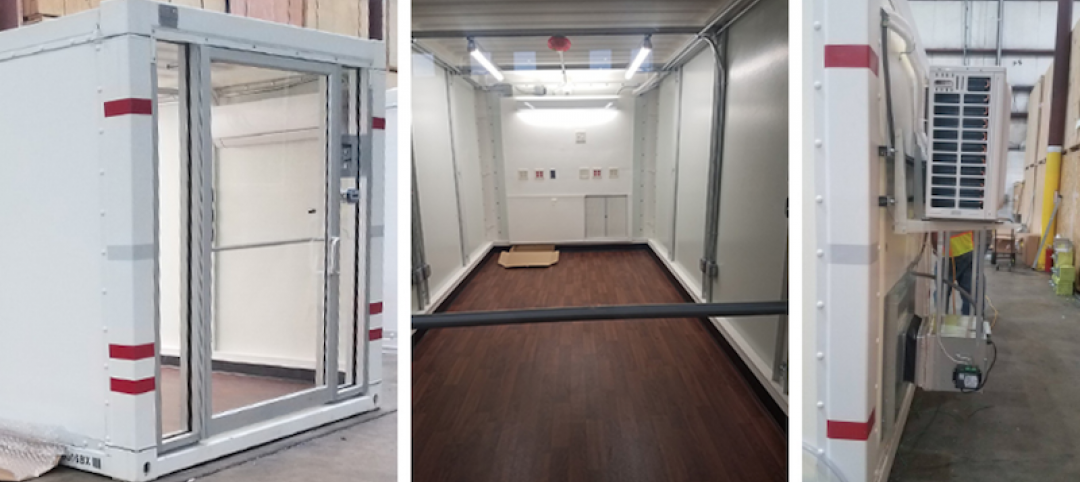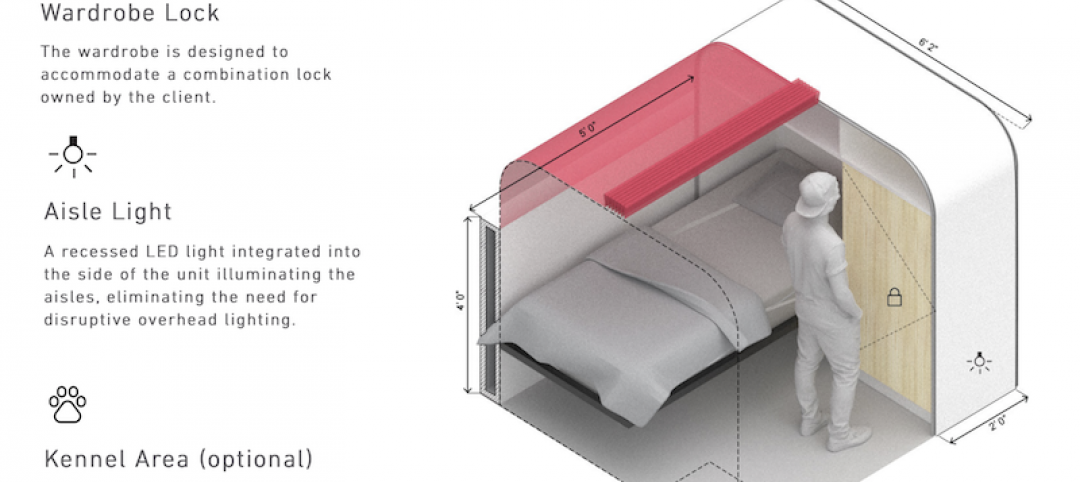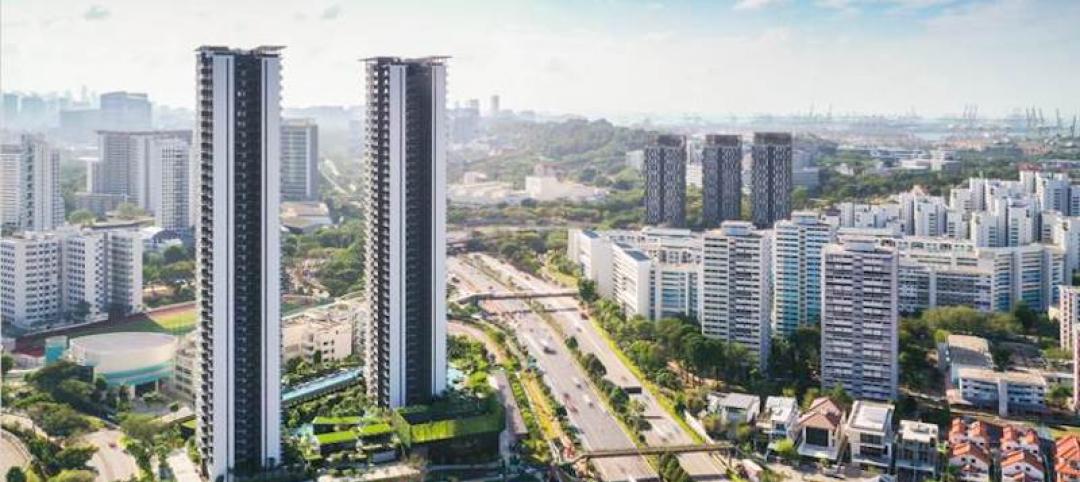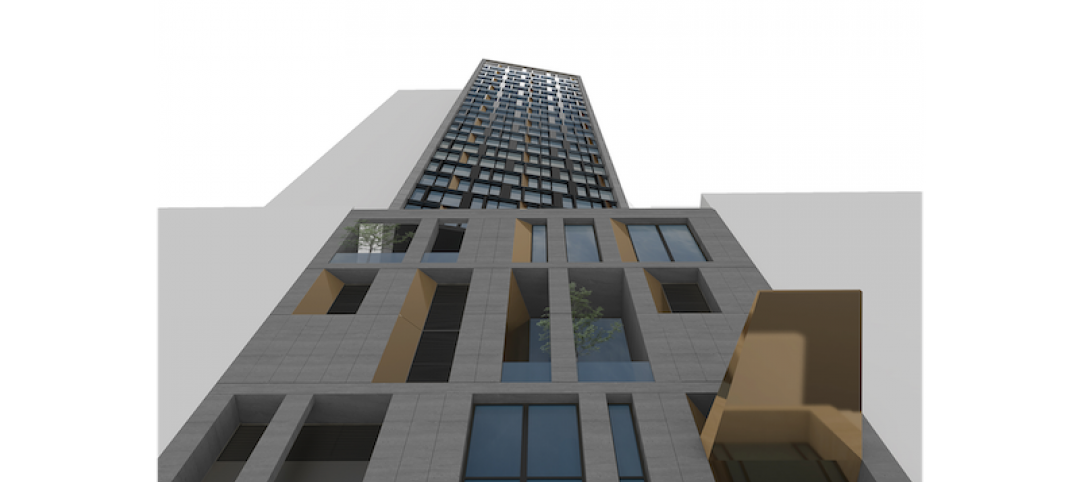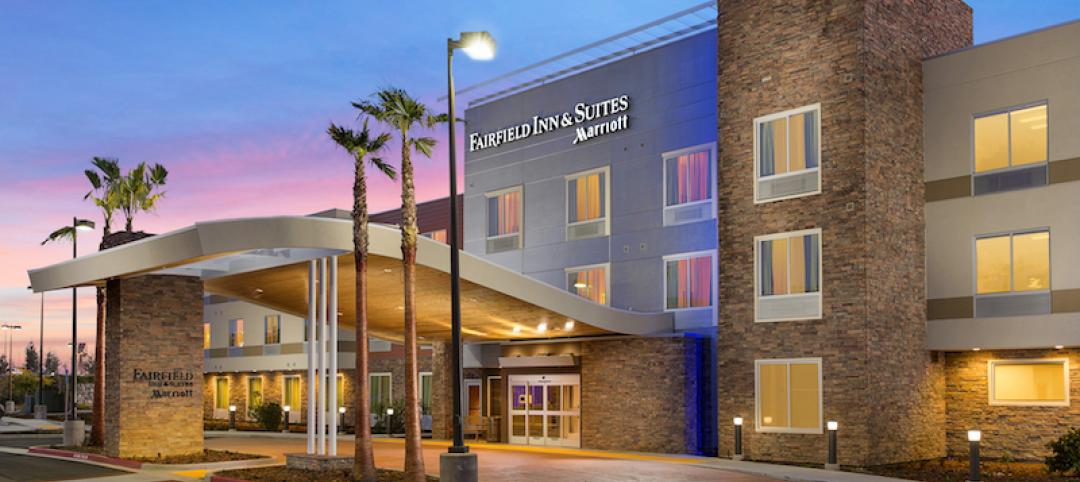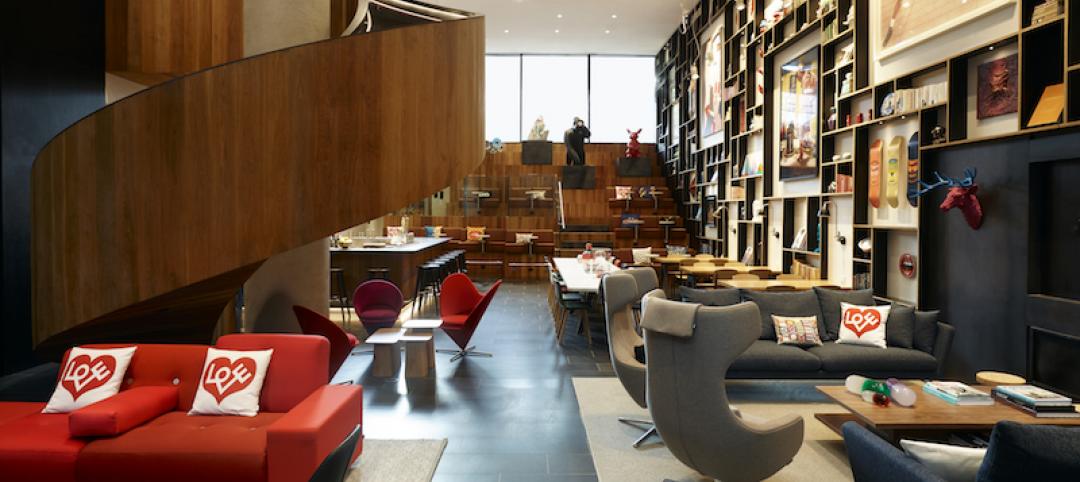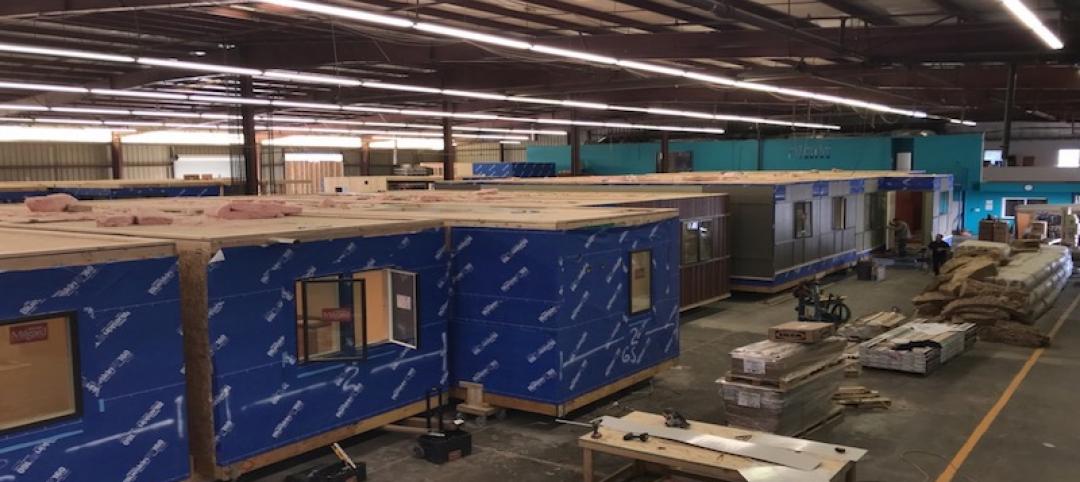Gensler, the global architecture firm, is currently working on nine citizenM-branded hotels across North America, including a 264-key hotel in the South Lake Union neighborhood of Seattle that, when it opens in May, will be that city’s first fully modular hotel.
Gensler is among a growing number of AEC firms that are incorporating prefabrication and modular construction into their project design. The hotel sector has been particularly receptive to modular construction, most notably Marriott International, which since 2015 has included prefab guestrooms and bathrooms in more than 50 of its projects.
The Building Team that worked on the citizenM project in Seattle stacked seven to eight modules per day, on average, and set all of the rooms in 89 days, reducing the project’s schedule by four months, and reducing construction waste by as much as 60%. (Mortenson is the GC on this hotel project.)
The rooms themselves are small; the width of a king-size bed and only 160 sf. But they are designed and built to luxury-brand standards with the latest control technology. The rooms will also include personal tablets that allow guests to track the hotel’s real-time sustainability performance.
ALSO SEE: Meet the masters of offsite construction
“Prefabrication has a lot of positive impacts: on construction speed, improved quality and construction tolerances, on people and processes,” observes Daniel Glaessl, Design Director for Gensler in its San Francisco Bay Area office.
He says that his office is using prefabrication “as often as possible.” But there are some challenges: manufacturing plants can be in remote locations, for one. (The modules for the citizenM hotel in Seattle were shipped to the Port of Seattle from a Europe-based supplier.) Glaessl adds that prefab requires more preplanning and longer lead times, and the components need to be designed so they can fit onto trucks for transport.
Clark Pacific sees growth in demand for prefabrication and modular construction solutions
As prefabrication and modular construction become more popular in the U.S., building teams and their clients have been turning to domestic supply partners. For example, Clark Pacific, a components provider that has operated out of West Sacramento, Calif., since 1963, is working with Gensler’s Seattle office through design assist on a separate citizenM hotel in San Francisco.
Clark Pacific is the single source for that building’s envelope, utilizing the supplier’s Infinite Panel, a standard frame and connection system that meets or exceeds Title 24, water, vapor, sound and fire code requirements. This project is entering the production phase in Clark Pacific’s Northern California plant that will prefabricate the hotel’s façade.
Façade manufacture is how Clark Pacific got started, says Mickey Ankheli, AIA, its Director of Architecture/Design-Build. But over the years it has expanded its product variety and delivery system.
Clark Pacific’s plant in Woodland, Calif., which sits on 120 acres, focuses on structural components and products for its glass division. The company’s 2-million-sf plant in Fontana, Calif., makes Infinite Panel and Architectural Precast products. And its factory in Adelanto, Calif., makes structural components.
Ankheli says his company is seeing a “lot of traction” in demand for prefabricated products from the multifamily and campus housing sectors. That demand is strengthening, he posits, because of the industry’s labor shortage. And prefab assembly is particularly well suited for tight urban settings.
But, he acknowledges, prefabricated delivery requires that design decisions “be locked in earlier, and architects need to understand these parameters.” His company now positions itself as a provider of turnkey design-build.
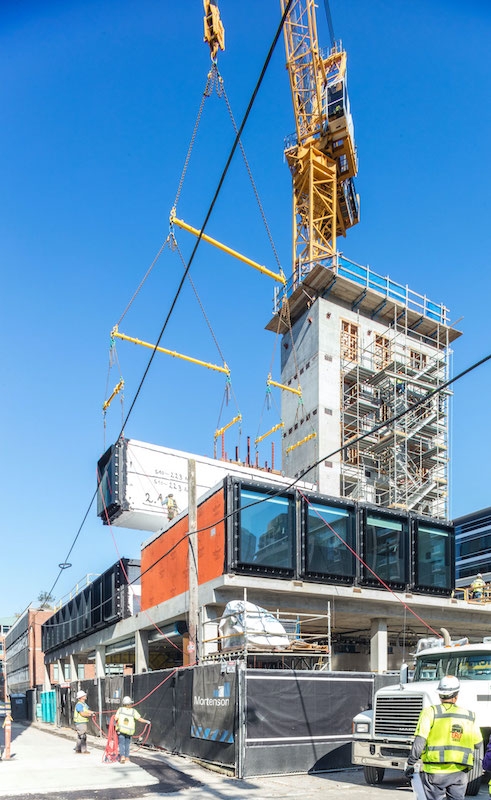
The construction of a citizenM hotel in Seattle used prefabricated modules that were placed seven to eight per day. Image: Gensler and Heywood Chen
“Prefab works best on projects that have a lot of iteration in their design,” says Glaessl. So design teams “need to be disciplined.”
That doesn’t mean there’s no flexibility in prefabrication or modular construction. Gensler and Clark Pacific are working on a parking structure for a technology client in the Bay Area. The structure, which will have a maximum capacity of 2,055 parking stalls, is being designed for adaptive reuse as office space, if market conditions warrant such a shift in use.
Ankheli recalls that, in midstream, the parking structure’s client wanted changes that included adding an athletic field to the project. While Clark Pacific had to retool a bit, Ankheli asserts that prefabrication actually made it easier to meet the client’s wishes.
The company, which sells into the west coast, including Arizona and Nevada, touts the resilience of its components, especially during seismic events. Clark Pacific sees its growth coming primarily from greater efficiency in serving its existing markets, says Ankheli.
Related Stories
Coronavirus | Apr 21, 2020
COVID-19 update: CallisonRTKL, Patriot, PODS, and USACE collaborate on repurposed containers for ACFs
CallisonRTKL and PODS collaborate on repurposed containers for ACFs
Modular Building | Mar 17, 2020
Danish hospital is constructed from 24 steel frame modules
Onsite construction was completed in two weeks.
Modular Building | Nov 18, 2019
A modular solution to help reduce homelessness
DOME is a Perkins and Will-designed prototype whose goal is to provide bridge housing to the unsheltered.
AEC Innovators | Aug 13, 2019
Stacking the deck: Marriott International embraces modular construction
The hotel giant has more than 50 projects in the works that incorporate prefab guestrooms or bathrooms.
Modular Building | Jul 3, 2019
World’s tallest modular building rises in Singapore
The state has been pushing for improvements in construction management.
Modular Building | May 13, 2019
This Marriott is poised to take over the title as the world’s tallest modular hotel
Danny Forster & Architecture designed the building.
Sponsored | Modular Building | Jan 22, 2019
Folsom Hotel opens five months early using modular construction
Early check in? With modular construction the answer is yes!
Modular Building | Oct 31, 2018
Europe’s citizenM is trying to crack into the U.S. hotel market with steel-framed modular construction
Projects in several cities are in various stages of development.
Modular Building | Oct 12, 2018
DeSimone Consulting Engineers designs the tallest modular hotel in the United States
The hotel was originally designed as a cast-in-place concrete structure.
Modular Building | Sep 25, 2018
Amazon invests in a prefab module supplier
Los Angeles-based Plant Prefab targets single- and multifamily construction.


